- Oct 12
- Addiction
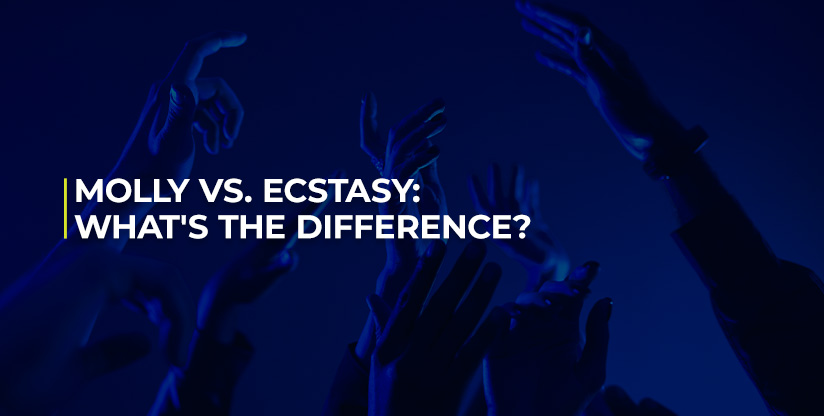
People commonly use molly and ecstasy as party drugs in an attempt to enhance their experience and improve their mood. Both drugs are widely found at music festivals, raves, concerts, clubs, house parties, and other events or entertainment venues.
These drugs utilize the same synthetic chemical, so why do they carry two different names? Below, you’ll learn about the differences between molly and ecstasy and their similarities. You’ll also learn about the effects of the drugs and treatment options.
The Difference Between Molly and Ecstasy
Molly and ecstasy are different forms of the same synthetic drug with the scientific name methylenedioxymethamphetamine (MDMA). MDMA appears in crystalline form or powder form when it’s at its purest. While molly and ecstasy are slang terms for the same drug, there are a few distinctions between the two substances. Here are the differences between ecstasy versus molly.
What Is Ecstasy?
Ecstasy is the pressed powder tablet version of MDMA. For the powder to be pressed into pill form, ecstasy is often mixed with other ingredients, which also helps reduce production costs. These ingredients can be harmful and produce undesirable effects on the person taking the substance. People can take ecstasy by swallowing the tablet or crushing it to snort it. They may also acquire it in a powder form to snort.
What Is Molly?
Molly comes from the term “molecular” and is thought to be purer than ecstasy because it doesn’t need extra ingredients to be pressed into a tablet. Molly appears in powder or crystal form, which is sometimes placed into a capsule for ingestion. If people don’t ingest molly, they can snort it, apply it to blotter paper or inject it.
While molly is assumed to be purer than ecstasy, molly can also be cut with other substances in the same way as ecstasy. Drugs marketed as molly on the street may not even contain MDMA, instead including substances like methylone, pentedrone, 4-MEC, MDPV or other substances.
The Drug Enforcement Administration (DEA) reports that molly and MDMA found on the streets are often cut or mixed with other substances or marketed as MDMA without containing the substance. Without MDMA, the molly sold on the streets containing other substances won’t have the desired effect on the individual taking it.
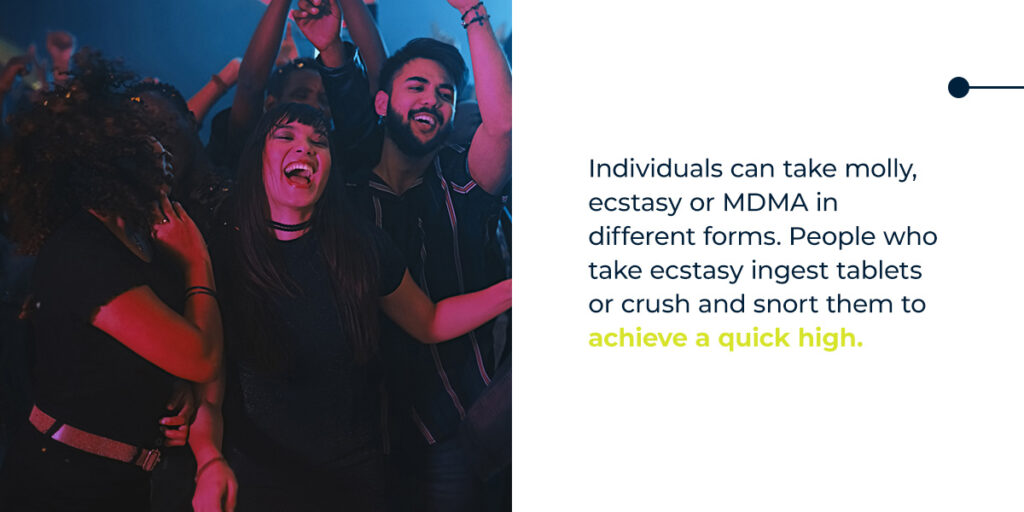
How Are They Used?
Individuals can take molly, ecstasy or MDMA in different forms. People who take ecstasy ingest tablets or crush and snort them to achieve a quick high. Molly can be snorted, placed in capsules for ingestion, applied to blotter paper or snorted. There are even liquid forms of MDMA that people can swallow.
Regardless of how a person takes molly or ecstasy, there is the risk of the substance being mixed with other stimulants, such as caffeine, to try and make the addition undetectable. These additional substances can cause adverse side effects and impact a person’s ability to accurately gauge the dose of different drugs they’re taking, which could create a potential for overdose if the drug is cut with something dangerous like fentanyl.
When Did Ecstasy and Molly Become Popular?
Ecstasy first became popular in the late ‘70s and early ’80s among psychiatrists who thought the drug enhanced patient communication and insights about their struggles. The drug did not undergo clinical trials or have approval from the FDA. It was also around this time that ecstasy became more popular on the street, frequently used at clubs, bars, parties and other events. Even today, ecstasy is still one of the most popular party drugs, as people believe it heightens their experience.
The “purer” form of MDMA, molly, became popular in the ’90s, particularly in rave culture. Molly and ecstasy can be found at raves, music festivals and other events throughout the country. Both drugs are prevalent among young adults and even teenagers.
Despite the risk both drugs have of containing additional substances, even dangerous ones such as fentanyl, they still maintain popularity within these scenes. The risks of MDMA use increase even more in these scenarios as it’s more likely for someone to mix the drug with other substances, like alcohol, at these events.
There are additional street names for MDMA that you might come across, including:
- E
- Clarity
- Lover’s Speed
- Peace
- Hug Drug
- Beans
- XTC
- Eve
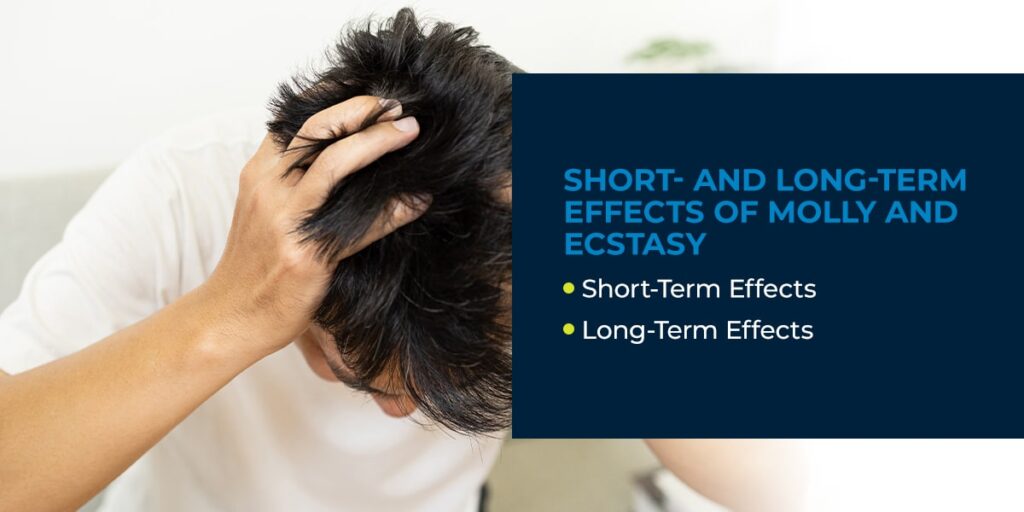
Short- and Long-Term Effects of Molly and Ecstasy
Since both drugs contain MDMA, they can have the same effect on a person. However, remember that molly and ecstasy can be cut with other substances, so the impact of taking the drug will vary based on what it’s been mixed with and the individual taking it.
Short-Term Effects
If you take a pure form of molly or ecstasy that only contains MDMA, you may feel these short-term effects as the drug starts to kick in:
- Increased feelings of empathy toward others
- Enhanced perception of senses
- Openness about emotional memories
- Increased extroversion
- Emotional vulnerability or warmth
While these are the effects people often desire when taking molly or ecstasy, other short-term effects are less desirable. Some of the adverse short-term side effects:
- Lack of judgment
- Depression and anxiety
- Confusion
- Grinding teeth
- Chills or sweating from increased body temperature
- Muscle tension
- Feelings of faintness
- Drug cravings
- Paranoia
- Dehydration
- Increased heart rate
- Sleep disturbances
These side effects are often more likely if a person takes a higher dose of MDMA but are also possible at lower amounts, depending on a person’s sensitivity. Some of these short-term effects can be dangerous. Consider the rise in body temperature. If a person takes a high dose of MDMA and then participates in high levels of physical activity, such as vigorous dancing or exercise, they could cause their body to increase to dangerous temperatures that could cause lasting effects on the brain and body.
Long-Term Effects
While some believe that repeatedly taking molly or ecstasy over a long period is less harmful than other substances, MDMA can have severe effects on the body after a person has taken the drug for a long time.
Some of the potential long-term effects of MDMA include:
- Lasting damage to the brain that impacts a person’s memory or cognitive abilities
- Brain damage affects a person’s ability to sleep, learn or regulate their emotions
- Damage to the central nervous system, potentially causing degenerative nerve endings and branches
- Lasting anxiety or depression
- Problems with appetite, which could cause weight fluctuations
- Heart disease
- An increased risk for issues with the blood vessels that could harm the brain
- Psychosis, such as hallucinations and delusions
- Kidney failure
- Convulsions
- Death
Since MDMA is commonly mixed with other substances, there is a risk that what someone is taking isn’t MDMA or is cut with something dangerous. A person could experience an overdose from taking the substance. The long-term effects can vary based on the individual and what the drug is mixed with.
MDMA Addiction and Withdrawal
The research on the risk of addiction to MDMA is varied. Still, there are plenty of signs that it has the potential to be just as addictive as other substances, mainly since it affects the same neurotransmitter systems as other drugs — norepinephrine, dopamine and serotonin.
People can experience negative physical and psychological symptoms from drug use yet continue using the substance, indicating dependency or addiction. Some people have also reported cravings for MDMA and withdrawal symptoms.
Some signs of addiction to MDMA include:
- A regular desire to use the substance
- Cravings to use the drug
- Continuing to use the substance despite the negative consequences
- Challenges or failure to quit using the substance
- Experiencing withdrawal symptoms when unable to use MDMA
- Spending money on the drug despite financial hardship
- Developing a higher tolerance, requiring a larger dose to achieve the same effect
- Engaging in risky behavior while under the influence of the substance
- Lack of personal hygiene
- Withdrawing from friends and family or interpersonal conflict
- Mood swings or changes in behavior
- New or increasing health issues
- Problems at school, work or home
- Failing to keep up with responsibilities
- Sleep disturbances
- Impact on mental health
These signs are the same as the signs of addiction to other substances, whether alcohol, cocaine, opioids or another drug. People with addictive personalities are also more likely to develop an addiction to MDMA. Individuals who believe they can’t enjoy an event or party without the substance may also exhibit signs of addiction, especially if they start seeking out parties just to use MDMA or take it home.
People who develop a dependency on MDMA can also experience withdrawal symptoms. The exact symptoms and severity will vary based on the individual, the purity of the drug, the other substances it’s mixed with and the frequency or dosage of their substance use. Some common withdrawal symptoms include:
- Fatigue
- Agitation
- Difficulty concentrating
- Depression or anxiety
- Lack of appetite
- Insomnia
- Paranoid thoughts
MDMA increases the amount of serotonin in the brain while a person is taking it, causing them to feel euphoric effects. When a person withdrawals from the substance, their brain lacks serotonin and needs to rebalance, creating intense feelings of depression and mood swings. People can also experience the various symptoms associated with depression, such as tiredness, lack of motivation, low self-esteem or inability to focus.
MDMA Treatment Options
The good news is that people with an MDMA addiction have various treatment options to help them improve their quality of life. Treatment helps people learn better coping mechanisms to change addictive behaviors and work toward recovery. Some treatment options include:
Detox and Withdrawal Management
Since people can develop a dependence on the drug and experience withdrawal symptoms, detox and withdrawal management are offered to help individuals overcome these feelings and focus on the rest of their treatment. Professionals can monitor your symptoms and provide the correct level of medical care to help you manage your symptoms.
You may also participate in a medication-assisted detox program to help you manage severe withdrawal symptoms, allowing you to direct your focus on the rest of your treatment and prevent a relapse.
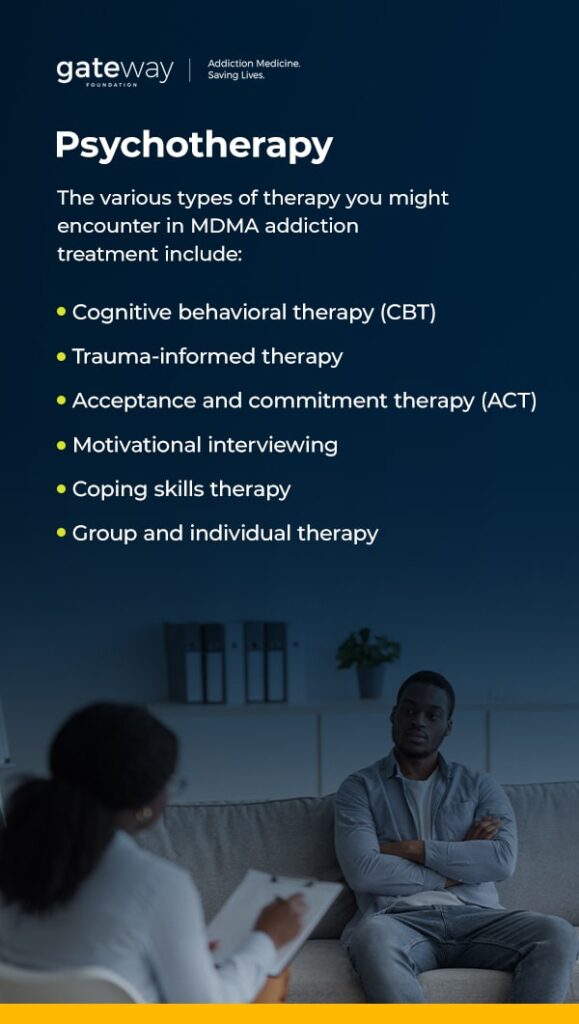
Psychotherapy
Therapy can help you analyze your thoughts and behaviors while getting to the root cause of your addiction. The various types of therapy you might encounter in MDMA addiction treatment include:
- Cognitive behavioral therapy (CBT): CBT programs help individuals analyze their current thoughts, beliefs and values to determine how they influence their current behaviors, modifying unhelpful and maladaptive thought patterns to help people break free from the cycle of addiction.
- Trauma-informed therapy: Trauma therapy helps individuals address their past traumatic experiences to reduce the symptoms that could contribute to their substance use as a way to cope.
- Acceptance and commitment therapy (ACT): ACT programs help people accept their emotions and their current situation so they can start focusing on their treatment.
- Motivational interviewing: Motivational interviewing helps individuals improve their readiness for change, whether they’re wary about treatment or believe they don’t have a problem with MDMA.
- Coping skills therapy: Learning coping skills will equip you with various tools to help you manage your triggers outside of treatment. Some coping skills include meditation, yoga, journaling, painting and hiking.
- Group and individual therapy: While you’ll participate in individual therapy frequently throughout treatment, you can also participate in group therapy to meet with others who share similar struggles and establish a support network of individuals who understand what you’re going through.
You’ll likely participate in a combination of these various therapies when you’re in treatment, helping you get to the root cause of your addiction. Each type of therapy can play a vital role in your recovery, helping you work through your past and assess your current behaviors to make positive improvements. You’ll also learn different coping mechanisms to manage your triggers and how to build a support network you can rely on outside of treatment.
Inpatient or Outpatient Treatment
A person has the option of completing an inpatient or outpatient treatment program based on the severity of their addiction and their circumstances.
During an inpatient treatment program, an individual may reside at the treatment center for 30 to 90 days, depending on their required level of care. They’ll participate in various therapies to help them in their recovery.
Inpatient treatment is ideal for individuals with a severe addiction who don’t have access to a support network outside of treatment. Or, there may be other people at their home who use substances, creating an environment they don’t wish to be around as they pursue sobriety. Residential treatment eliminates access to substances like MDMA, reducing temptation and allowing a person to progress through treatment.
Outpatient treatment is better suited to individuals with less severe addiction and a safe and sober environment at home. People often choose outpatient treatment if they have outside responsibilities to maintain while overcoming addiction, such as childcare, education or work. The intensity of outpatient programs can vary, with some attending treatment every day or a few times per week for several months.
An addiction specialist can help you determine which option would be best for you by assessing your history with MDMA and the severity of your addiction. They’ll ask you questions about your home life, how long you’ve been using MDMA, the frequency of your use and other questions to determine the appropriate level of care.
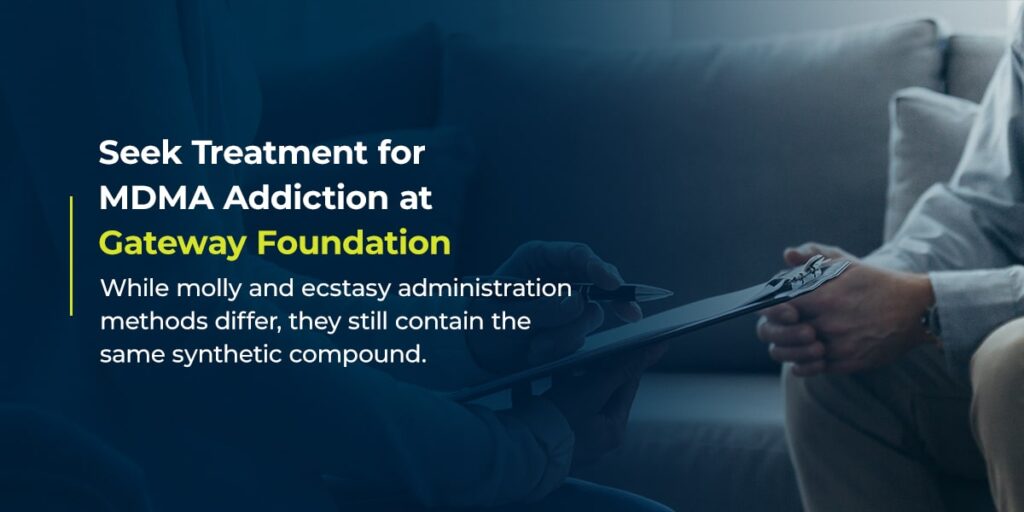
Seek Treatment for MDMA Addiction at Gateway Foundation
While molly and ecstasy administration methods differ, they still contain the same synthetic compound. Molly is thought to be the purer of the two, but both can be mixed with different substances, creating undesirable and harmful effects on a person’s physical and mental well-being. People can even become addicted to MDMA, which has numerous negative consequences on a person’s life.
If you or a loved one is struggling with addiction to MDMA, Gateway Foundation is here to help. We have several levels of care to help you find a program that fits your needs, and our addiction specialists will personalize your treatment plan to ensure the root cause of your addiction is addressed. We utilize various therapies and relapse prevention planning to help sustain your sobriety long after recovery.
Gateway Foundation can help you through every stage of your recovery journey, whether you’re currently in treatment or aftercare. Contact us today to get started.


